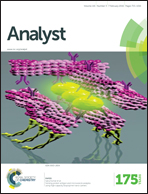Single-molecule visualization of ROS-induced DNA damage in large DNA molecules†
Abstract
We present a single molecule visualization approach for the quantitative analysis of reactive oxygen species (ROS) induced DNA damage, such as base oxidation and single stranded breaks in large DNA molecules. We utilized the Fenton reaction to generate DNA damage with subsequent enzymatic treatment using a mixture of three types of glycosylases to remove oxidized bases, and then fluorescent labeling on damaged lesions via nick translation. This single molecule analytical platform provided the capability to count one or two damaged sites per λ DNA molecule (48.5 kb), which were reliably dependent on the concentrations of hydrogen peroxide and ferrous ion at the micromolar level. More importantly, the labeled damaged sites that were visualized under a microscope provided positional information, which offered the capability of comparing DNA damaged sites with the in silico genomic map to reveal sequence specificity that GTGR is more sensitive to oxidative damage. Consequently, single DNA molecule analysis provides a sensitive analytical platform for ROS-induced DNA damage and suggests an interesting biochemical insight that the genome primarily active during the lysogenic cycle may have less probability for oxidative DNA damage.


 Please wait while we load your content...
Please wait while we load your content...